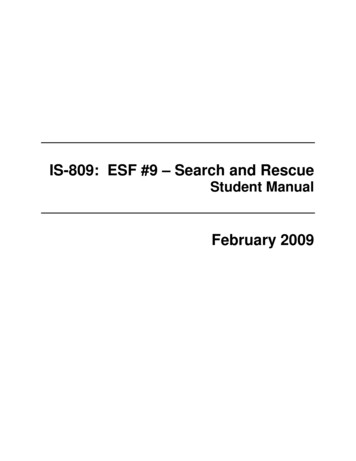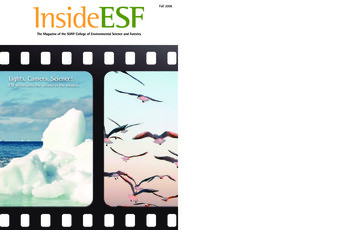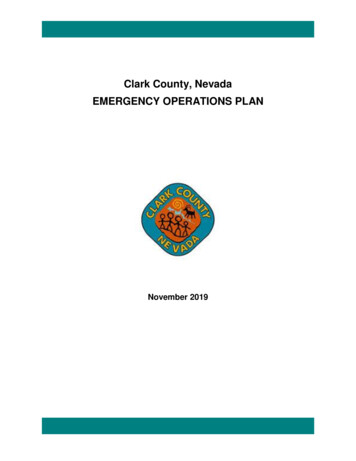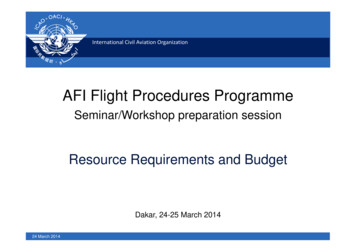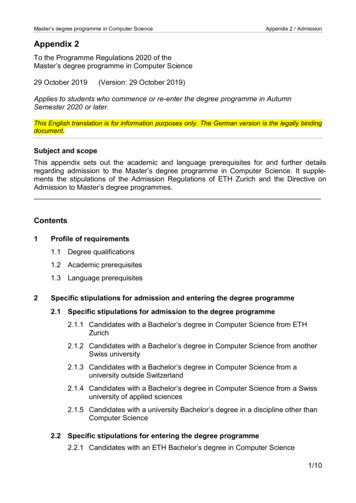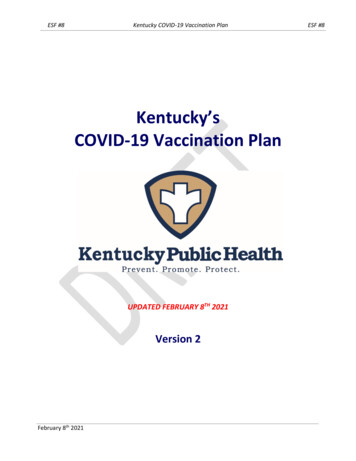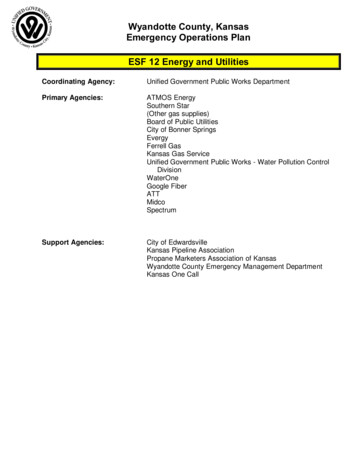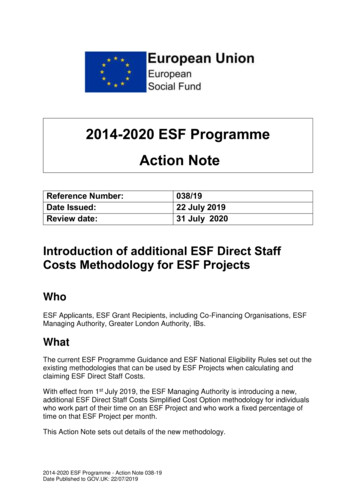
Transcription
2014-2020 ESF ProgrammeAction NoteReference Number:Date Issued:Review date:038/1922 July 201931 July 2020Introduction of additional ESF Direct StaffCosts Methodology for ESF ProjectsWhoESF Applicants, ESF Grant Recipients, including Co-Financing Organisations, ESFManaging Authority, Greater London Authority, IBs.WhatThe current ESF Programme Guidance and ESF National Eligibility Rules set out theexisting methodologies that can be used by ESF Projects when calculating andclaiming ESF Direct Staff Costs.With effect from 1st July 2019, the ESF Managing Authority is introducing a new,additional ESF Direct Staff Costs Simplified Cost Option methodology for individualswho work part of their time on an ESF Project and who work a fixed percentage oftime on that ESF Project per month.This Action Note sets out details of the new methodology.2014-2020 ESF Programme - Action Note 038-19Date Published to GOV.UK: 22/07/2019
For completeness this Action Note also confirms the other, existing ESF Direct StaffCost methodologies which will remain in place alongside the new option.The ESF Managing Authority are working to update the full suite of existing ESFguidance products and forms impacted by this change.In the meantime, this Action Note can be used as formal guidance by ESFApplicants, Grant Recipients, Managing Authority and Intermediate Bodies.ClearedJanet Downes/Steve Spendlove2014-2020 ESF Programme - Action Note 038-19Date Published to GOV.UK: 22/07/2019
BackgroundRegulatory basis for the new Simplified Cost Optionstaff costs methodology1. Article 68a (para 5) of the EU Omnibus Regulations (PE-CONS 13/18) explainsthat staff costs for those members of staff who work part of their assigned hours onan ESF operation may have their staff costs calculated as a fixed percentage of theirannual gross employment costs where they work a fixed percentage of time on theoperation per month. Under this arrangement the employer has no obligation toestablish a separate working time registration system (timesheet). However, theemployer is required to issue appropriate documentation setting out the percentageof time that the individual will work each month. In light of the above regulation, theESF MA for England has decided to adopt this additional methodology with effectfrom Monday 1st July 2019.2. It should be noted that use of the new, additional methodology is not mandatory.3. Existing ESF Project Grant Recipients may request adoption of the newmethodology for relevant staff at any time from 1st July 2019 onwards. Requests toadopt the new methodology should be made in advance of any claims beingsubmitted based on the new Simplified Cost Option as per the ‘Project ChangeRequest’ section of this Action Note.4. Existing and new ESF Applicants may include this new option as part of theirgranular budget and ESF Project financial forecasts for brand new applications. Iftheir Full Application is already in appraisal, any request should be discussed andagreed with the appraiser before amendments are made to any financialdocumentation.ESF Direct Staff Cost Methodologies5. Listed below are the current, acceptable ESF methodologies which can be used tocalculate ESF Direct Staff Costs.Existing ESF Direct Staff Cost Methodology 1: Staff working 100% of theircontracted time on the ESF Project.6. For staff working full time or part-time and who spend 100% of their contracted /assigned hours on the ESF operation then costs will be claimed based on annualgross employment costs.Examples: College A employs Ms Smith on a part time basis (40 hours per month) andshe spends 100% of her assigned time (all 40 hours) on ESF Operation A.2014-2020 ESF Programme - Action Note 038-19Date Published to GOV.UK: 22/07/2019
The college claims actual salary costs (see ESF Programme Guidance) Local Authority B employs Ms Hussain on a full time basis (144 hours permonth) and she spends 100% of her assigned time on ESF (i.e. all 144 hoursper month / 1872 hours per year). The local authority claims actual salarycosts (see ESF Programme Guidance)Existing ESF Direct Staff Cost Methodology 2: Staff working part of their time onan ESF Project but for variable hours each month and where the applicantresponded to an ESF open call published on or after 17 March 2016 or where: The applicant submitted their ESF Technical Assistance (TA) application aspart of a joint ESF/ERDF TA operation and the ESF Managing Authorityagreed the applicant could adopt the new 1720 hourly date calculation; The applicant submitted an ESF (stage 2) Community Led Local Development(CLLD) application as part of an ESF and ERDF multi-fund operation or wherea mono-fund application was submitted.7. Under this methodology, staff who are required to work less than 100% of theircontracted hours on an ESF operation - but whose hours of work on ESF will varyeach month should have their hourly wage rate calculated based on a set annualgross employment costs figure, using the 1720 calculation method set out in the ESFProgramme Guidance and ESF National Eligibility Rules published on GOV.UK.For example: Local Authority E employs Mr Jones on a full time basis. His contract ofemployment requires him to spend time on an ESF project and an ERDFproject run by the council. He will be required to work for different periods oftime each month for each project. A timesheet will be required to record howlong he spends working for each project and to ensure that the local authoritycan check to ensure that Mr Jones does not exceed more than 100% of histotal contracted hours on the two ESIF projects. The staff costs are calculatedusing 1720 hourly wage rate calculation and timesheet. College F employs Ms Smith on a part-time basis (1040 hours per year). Shewill be required to work for the college delivering education classes as well ashelp-out on the College’s ESF project as and when required. This means shewill be spending less than 100% of her contacted hours on ESF. Her hoursworking on the project will vary from month to month. The College will requireher to keep a timesheet and her ESF staff costs will be calculated using anhourly rate (1720 staff costs calculation) along with the staff timesheet.8. It is likely that the unit costs’ (hourly rate) for staff employed under staff cost method 2’ will appear to be higher than for staff paid under method 4 arrangements.However, it should be borne in mind that method 2 already factors in annual leaveand also involves the completion and retention of additional documentary evidencesuch as timesheets.2014-2020 ESF Programme - Action Note 038-19Date Published to GOV.UK: 22/07/2019
Existing ESF Direct Staff Cost Methodology 3: Staff working part of their time onan ESF Project but for variable hours each month and where the applicant appliedfor their original ESF Funding under Versions 1 and 2 of the ESF National EligibilityRules.This includes ESF Projects who responded to open calls published up to 16 March2016 where they do not meet the criteria for using the newer 1720 hourly ratemethodology.9. Under this methodology, if a staff member is working full-time but only workingpart of their time on ESF the following calculations should be used: work out how many hours they work in a year. This is 52 weeks multiplied by 5days, less the number of days of annual and public holidays they are entitledto, multiplied by the number of hours they work each day; andDivide their actual annual salary by the number of hours worked as above toestablish their hourly rate.Claims for ESF should then be based on the number of hours worked on ESFmultiplied by the hourly rate.New ESF Direct Staff Cost Methodology 4: Staff working less than 100% of theirtotal contracted time on ESF with a fixed percentage of time worked on the ESFProject per month10. For staff who fall into this category, a flat rate percentage of their actual grossemployment costs per month can be claimed. This percentage has to be in-line /consistent with the percentage of time spent each month on that ESF Project. Forexample: ESF Provider C employs Mr Jordan on a full-time basis but he works a fixed50% of his time each month on the ESF Project. This means that Provider Ccan claim 50% of Mr Jordan’s monthly gross employment costs as ESF DirectStaff Costs. His payslip shows that his monthly gross employment costs are 1,500.- 50% (fixed percentage of contracted hours/time spent on ESF Project) x 1,500 (total actual monthly gross employment costs) 750 (total ESFDirect Staff Costs that can be claimed per month). ESF Provider D employs Ms Singh on a part-time basis of 30 hours per week.Of this she works a fixed percentage of 40% of her time on the ESF Project.This means that Provider D can claim 40% of Ms Singh’s monthly grossemployment costs as ESF Direct Staff Costs. Her payslip shows that hermonthly gross employment costs are 1,000.- 40% (fixed percentage of contracted hours/time spent on ESF Project) x 1,000 (total actual monthly gross employment costs) 400 (total ESFDirect Staff Costs that can be claimed per month).2014-2020 ESF Programme - Action Note 038-19Date Published to GOV.UK: 22/07/2019
11. Under this methodology, timesheets do not need to be completed or submittedas evidence when making claims under this staff cost method.12. However, projects must put in place the following documentation and be able toproduce this as supporting documentary evidence against any ESF Direct StaffCosts claimed under this methodology as and when requested by the ManagingAuthority or other audit body.13. A contractual document from the employer to the employee confirming the fixedpercentage of time they will work on the ESF Project each month. This could be adocument such as: an HR letter; a Job Description; or a contract of employment; or another contractual document issued by the employer to the employee.The contractual document must clearly explain the fixed percentage of time the staffmember will spend on the ESF project per month (see Annex 1).If a staff member will be working for more than one ESF Project a single contractualdocument can be used to set out the fixed percentage of time the individual willspend on each ESF Project per month, ensuring the combined total does not exceed100% of their total overall contracted hours.14. Evidence of the actual gross employment costs used to calculate the monthlyESF Direct Staff Costs for that individual.15. This will need to be provided to the ESF Managing Authority and/or Auditors onrequest in each case.New ‘Fixed Percentage’ Staff Costs methodology action to be taken at key stages of the ESF projectlifecycle.16. The new ‘Fixed Percentage’ staff cost methodology has implications for keystages of the ESF programme. This Action Note explains what action needs to betaken to implement the new staff cost methodology at each key stage.Project Application / Appraisal17. In addition to the evidence and explanations needed for other existing staff costmethodologies, at the project application / appraisal stage the Managing Authoritywill need to understand:2014-2020 ESF Programme - Action Note 038-19Date Published to GOV.UK: 22/07/2019
how any proposed ‘fixed percentage’ staff costs have been calculated for jobroles where that methodology applies; the financial controls that the project has put in place to prevent any overclaiming’ of staff costs for individuals working across more than one ESFProject; and sample evidence of the contractual document that has been/will be put inplace as supporting evidence for individuals where the Fixed Percentage ratemethodology is to be used, ensuring this is compliant with the requirements inthis Action Note.18. All ESF project applicants are required to prepare and submit a granular budgetfor their ESF project as part of their ESF Full Application. This document must list alljob roles applicable to the ESF Project, including the specific ESF Direct Staff Costsmethodology being applied to each individual job role for the ESF Project – acrossthe lead Grant Recipient organisation and any delivery partners.19. A sample granular budget template is available on GOV.UK – although projectscan design their own. If using their own granular budget template, applicants mustensure it contains at least the same level of information and detail as the GOV.UKsample template.20. If a project is successful in obtaining ESF funding, the staff/job roles list andassociated staff costs information per job role will act as a ‘Master List’ against whichany financial claims for ESF Direct Staff Costs will be checked.21. Any changes to the staff costs for one or more roles in the ‘Master List’ should bereported by the Applicant/Grant Recipient to the Managing Authority before anycosts are incurred against any amended staff cost calculations/rates.22. Applicant projects will need to provide a sample of the contractual document tobe used for any staff who will be subject to the new ‘Fixed Percentage’ methodology,as part of their supporting documentation’ for their application. Applicants will needto make sure that their HR letter and Job Description etc. meets requirements set outin Annex 1 so that it will meet the new requirements that will apply to staff costmethod 2 method 2 - as well as the staff cost methods 1 and 3. Annex 1 of thisaction note lists key information that needs to be covered in the HR documentation.Project Inception Visit (PIV) Stage23. In addition to the current checks undertaken at the PIV stage of the projectlifecycle, with the introduction of the new ‘Fixed Percentage’ methodology theManaging Authority will also: check if a new project is expecting to retain or change any of the staff costsmethodologies set out in their granular budget at the application/fundingagreement stage;2014-2020 ESF Programme - Action Note 038-19Date Published to GOV.UK: 22/07/2019
o If so, the MA will request a new ‘Master List’ of all job roles for the ESFProject with the relevant, up-to-date staff costs methodologiesreflected. double-check that appropriate paperwork is in place that is likely to meetrequirements under future audit.24.Where the new ‘Fixed Percentage’ methodology is being used for one or morejob roles in that ESF Project, undertake a sample check of at least one case toensure the fixed rate calculation is being applied correctly and is understood by theGrant Recipient.25. Any findings relating to the use of the new ‘Fixed Percentage’ methodologyshould be documented in the PIV report and any issues identified addressed as partof the usual PIV action points resolution processes.Claims Stage26. As per current ESF Programme processes for financial claims, the ManagingAuthority will conduct DBEC checks based on the existing sampling processes.27. Where the Managing Authority Desk-Based Evidence Check includes ESF DirectStaff Costs which relate to an individual where the new ‘Fixed Percentage’methodology has been applied, the Grant Recipient will need to provide:a) a copy of the contractual document which confirms the fixed percentage oftime per month the employee is working on the ESF Project;b) a copy of the payslip and any other documents where necessary whichshow the actual gross employment costs which have been used to calculatethe ESF Direct Staff Costs for the selected transaction line.28. As the ‘Fixed Percentage’ methodology is a Simplified Cost Option, there is norequirement for defrayal evidence or timesheets for these specific cases.Article 125 On The Spot Visit (OTSV) Checks29. As per current ESF Programme processes, the Managing Authority will conductOn-The-Spot Visits based on existing processes and checklists.30. Where the Managing Authority On-The-Spot Visit checks include ESF DirectStaff Costs which relate to an individual where the new ‘Fixed Percentage’methodology has been applied, the Grant Recipient will need to provide:2014-2020 ESF Programme - Action Note 038-19Date Published to GOV.UK: 22/07/2019
a) a copy of the contractual document which confirms the fixed percentage oftime per month the employee is working on the ESF Project;b) a copy of the payslip and any other documents where necessary whichshow the actual gross employment costs which have been used to calculatethe ESF Direct Staff Costs for the selected transaction line.31. Again, as the ‘Fixed Percentage’ methodology is a Simplified Cost Option, thereis no requirement for defrayal evidence or timesheets for these specific cases.Project Change Requests32. If an existing Grant Recipient wishes to adopt the new ‘Fixed Percentage’methodology for one or more of their current employees, the Grant Recipient will firstneed to email their ESF Contract Manager explaining which job roles they would liketo switch over to the new calculation and from which date. The Grant Recipientshould provide a full, updated ‘Master List’ of all job roles for their ESF Project aspart of their email request – again, this document must list all job roles applicable tothe ESF Project, including the specific ESF Direct Staff Costs methodology beingapplied to each individual job role for the ESF Project – across the lead GrantRecipient organisation and any delivery partners.33. The Grant Recipient should also provide confirmation in the same email of theoverall expected impact on their ESF Project costs – for example, will their overalltotal project costs increase as a result of the change and, if so, by how much.34. The Contract Manager will then consider whether a formal Project ChangeRequest (PCR) form needs to be completed by the Grant Recipient – for example, ifthe impact on total ESF Project costs is likely to exceed tolerances which will thentrigger the need for a formal PCR or whether, if the proposed change is withintolerances, they can agree the changes via email.35. In all cases the Contract Manager must ensure the staff cost details in the new,proposed ‘Master List’ are correct and based on eligible and acceptable ESF DirectStaff Cost methodologies set out in this Action Note, the ESF National EligibilityRules and the ESF Programme Guidance.36. Once all relevant change action has been taken, the Contract Manager mustnotify the Grant Recipient of the outcome of their request – either via the FundingAgreement/MOU Variation process if the change has been managed via a formalPCR or via an email if it is below PCR tolerances.37. A copy of any revised ‘Master List’ should be stored in the Contract Manager filesto support future claims and OTSV checks.2014-2020 ESF Programme - Action Note 038-19Date Published to GOV.UK: 22/07/2019
Action38. New or existing ESF Applicants to consider whether use of the new ‘FixedPercentage’ methodology could be applicable to their current and/or futureapplications for ESF funding.39. Existing Grant Recipients to consider whether they want to request a switch tothe new ‘Fixed Percentage’ methodology for any of their current ESF Project staffwho fulfil the eligibility criteria.40. ESF Managing Authority staff, including Intermediate Bodies, to take action asper this Action Note for any new or existing ESF Projects requesting use of the new‘Fixed Percentage’ methodology.Contact41. If you have any questions about this Action Note please contact ESF.20142020@DWP.GOV.UK2014-2020 ESF Programme - Action Note 038-19Date Published to GOV.UK: 22/07/2019
Annex 1HR Letter / Job Description / Contractual Documentation Requirements All staff must have a HR letter / job description / or other contractualdocumentation. Either singularly, or as a combination, the documentation MUST state that:o The post is ESF – funded.o Include the date that the post is funded from.o Explain whether or not the person will be spending all or part of theirtime on the ESF project. If the staff member is only spending part of their time one the ESF project,explain whether or not they will be working for:o a set % of time each month (and state the percentage and number ofhours this will be per month) oro variable % of time each month (also see ESF Programme guidance on1720 hourly rate calculations and timesheet requirements). The documentation must clearly state what other ESIF / EU-funded projectsthe person may be working on (if he/she is only working for part of their timeon ESF) – projects and explain the total number of hours they will beexpected to work on ESIF / EU programme funded projects. The documentation must have the ESF or ESIF logo. The Job Title in the documentation must match the job title in the latestorganogram provided to the ESF Managing Authority for your project. If your project is a YEI Project, the documentation must include a YEI specificstrapline, as detailed in the Branding and publicity requirements for the 2014to 2020 European Regional Development Fund and the European SocialFund published on GOV.UK.2014-2020 ESF Programme - Action Note 038-19Date Published to GOV.UK: 22/07/2019
for their original ESF Funding under Versions 1 and 2 of the ESF National Eligibility Rules. This includes ESF Projects who responded to open calls published up to 16 March 2016 where they do not meet the criteria for using the newer 1720 hourly rate methodology. 9. Under this methodology, if a staff member is working full-time but only working
